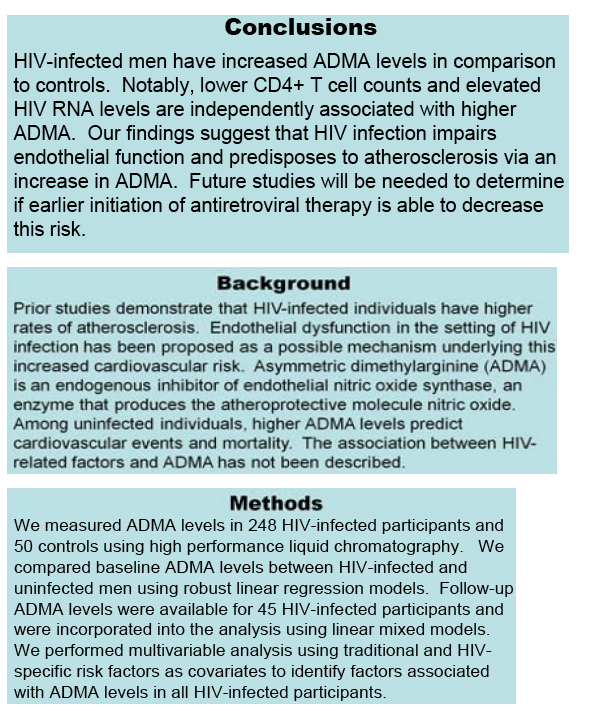 |
 |
 |
| |
Lower CD4+ Counts and Detectable HIV Viral Load are Associated With Elevated Levels of ADMA in HIV+ Patients
|
| |
| |
Reported by Jules Levin
CROI 2012 March 5-8 Seattle WA
Rushi Parikh, Rebecca Scherzer, Elaine Nitta, Anna Leone, Peter Ganz, Jeffrey Martin, Steven Deeks, and Priscilla Hsue
University of California, San Francisco
ABSTRACT
Lower CD4+ Counts and Detectable HIV Viral Load Are Associated with Elevated Levels of Asymmetric Dimethylarginine in HIV+ Patients
R Parikh, R Scherzer, C Grunfeld, A Leone, E Nitta, P Ganz, J Martin, S Deeks, and Priscilla Hsue
Univ of California, San Francisco, US
Background: Prior studies demonstrate that HIV+ individuals have higher rates of atherosclerosis. Endothelial dysfunction in the setting of HIV infection has been proposed as a possible mechanism underlying this increased cardiovascular risk. Asymmetric dimethylarginine (ADMA) is an endogenous inhibitor of endothelial nitric oxide synthase, an enzyme that produces the atheroprotective molecule nitric oxide. Among uninfected individuals, higher ADMA levels predict cardiovascular events and mortality. The association between HIV-related factors and ADMA has not been described.
Methods: We measured ADMA levels in 212 HIV+ men and 50 controls using HPLC. We compared baseline ADMA levels between HIV+ and HIV- participants using robust linear regression models. Follow-up ADMA levels were available for 45 HIV+ participants and were incorporated into the analysis using linear mixed models. We performed multivariable analysis using traditional and HIV-specific risk factors as covariates to identify factors associated with ADMA levels in all HIV+ participants.
Results: HIV+ men were somewhat older (median age 49 vs 42), less often Caucasian (67% vs 78%), and had higher rates of hypertension and dyslipidemia than HIV- men. The median duration of HIV infection was 6 years (IQR 3 to 10), CD4+ T cell count was 592 cells/mm3 (372 to 775), and two-thirds were treated with ART with HIV RNA level <75. ADMA levels were higher in HIV+ patients compared to controls (mean±SD, 0.47±0.09 vs 0.44±0.07 mM, p=0.019), but the association weakened after controlling for traditional cardiovascular risk factors and C-reactive protein (+0.028, 95%CI -0.0005 to 0.057, p = 0.054). Lower current CD4+ T cell counts, detectable HIV RNA levels, and smoking were independently associated with higher ADMA levels.
Conclusions: HIV+ men have modestly increased ADMA levels in comparison to controls. Notably, lower CD4+ T cell counts and elevated HIV RNA levels are independently associated with higher ADMA. Our findings suggest that HIV infection impairs endothelial function and predisposes to atherosclerosis via an increase in ADMA. Future studies will be needed to determine if earlier initiation of antiretroviral therapy is able to decrease this risk.






|
| |
|
 |
 |
|
|